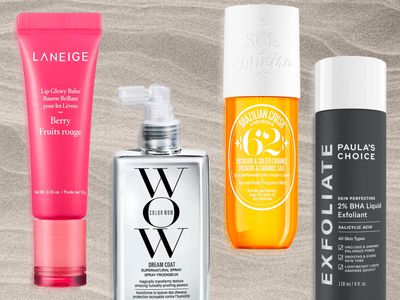
@claytonhawkins / Instagram
In This Article
What Is Heat Damage? How to Prevent and Treat Heat Damage Apply a Heat Protectant Use a Hydrating Shampoo and Conditioner Wash Less Frequently Avoid Harsh Chemicals Use Masks Pick Safer Tools Try a Heat Damage Reverser
Whatever type of hair you have, there's a good chance you've taken a hot tool to it. Whether that's a curling iron, blow dryer, diffuser, flat iron, or some combination of the above, most of us involve heat in our hair styling routine at least some of the time. Unfortunately, it can do a number on our tresses.
To get to the bottom of how to stop heat damage in its tracks, we went to the experts—board-certified dermatologist Nazanin Saedi, MD, FAAD, and pro hairstylist Ericka Verrett. Read on to learn about every step you can take to mitigate this unfortunate occurrence.
Meet the Expert
- Nazanin Saedi, MD, FAAD, is a board-certified dermatologist at Plymouth Meeting Dermatology in Philadelphia.
- Ericka Verrett is a hair stylist affiliated with SpoiledChild.
What Is Heat Damage?
It’s pretty straightforward: Heat damage is when your hair gets damaged by applying heat to it. “You know your hair is damaged when it appears dehydrated, dull, limp, and frizzy. Damaged hair can also feel rough and brittle,” explains Saedi.
If any of those attributes describe your hair, you're probably wondering if the situation can be reversed. "While heat damage cannot be physically reversed, there are certainly ways to visibly reverse the effects and to strengthen and prevent further damage," explains Verret. Sadei adds that "heat damage can change the structure of the hair. It can damage the cuticle, strip the hair of its protective oils, make strands more porous, and change the structure of the keratin within it." This means that while you may be able to get your hair into a better-looking and feeling state, you can't exactly undo what's been done.
Let's examine how you can prevent heat damage and improve your hair if it's already happened.
How to Prevent and Treat Heat Damage
01 of 07
Apply a Heat Protectant
Applying a heat protectant before exposing your hair to heat is the simplest way to prevent heat damage. “Heat and UV protectants are some of the best ways to help prevent damage and to help protect already damaged hair,” says Verrett. Heat protectants “both hydrate and protect the hair strand,” explains Saedi. “The ingredients that protect it do so by creating a barrier that acts like a heat shield.”
Saedi suggests “a heat protectant like Rahua’s Heat Protectant Shield ($38), which has hydrating avocado, castor seed, and almond oils and shea butter, and serves as a shield for temperatures up to 425°F.”
02 of 07
Use a Hydrating Shampoo and Conditioner
Even before styling your hair, you can begin preventing heat damage by properly moisturizing during your wash routine. “Heat protection starts in the shower,” says Saedi. “I like Seaweed Bath Co’s Heat Shampoo ($13) and Heat Conditioner ($13) because they are clean, gentle formulas that help retain moisture and provide a protective barrier from heat.” She also recommends using “a shampoo tailored to your natural hair type and conditioners formulated to hydrate and repair damaged hair,” applying the latter to the lower half or third of your strands.
Verret agrees on the importance of shampoo and conditioner. “Moisture gives the hair the ability to stretch. Without it, our hair becomes brittle… leaving it a candidate for further breakage,” she explains. “Hair loses a lot of moisture from heat damage.” The right conditioner can help “lock in and seal the shaft, preventing further damage and restoring the barrier.”
03 of 07
Wash Less Frequently
The more frequently you wash your hair, the less time your scalp has to replenish its natural oils. “Washing your hair less often will help [it] heal by allowing your natural oils to create a moisture barrier,” says Verrett. In addition to washing less often, you might want to do a moisturizing pre-wash when you do. “Some might want to use an oil, or even a conditioner, on dry ends before shampooing,” she suggests.
Saedi points out that, while it’s important to allow your scalp enough time to replenish its oils, you also want to avoid washing too rarely: This can cause product build-up and excess oil and dirt. She says you’ll want to consider factors including “an oily versus dry scalp, curly versus dry hair, hair thickness and texture, etc.,” when deciding how frequently to wash your hair.
04 of 07
Avoid Harsh Chemicals
It’s so much easier said than done, but avoiding bleach and permanent dye will make your hair less susceptible to heat damage. “Permanent hair color and bleach can play a significant role in damaging your hair, especially when combined with daily heat styling,” explains Verrett. To avoid this, “I recommended investing in an all-star home care regimen to help [maintain] overall hair health,” she says; This includes “color safe-, hydrating-, bond-strengthening shampoos and conditioners,” heat protectants, and hair supplements. Sadei adds that the chemicals in harsh dyes and bleach will strip your hair of moisture and can lead to it becoming brittle.
05 of 07
Use Masks
Once reserved for special occasions, hair masks are now considered a valuable addition to a regular hair routine. Indeed, Verrett tells us they are a must: “Whether or not you have any damage, I highly recommend masking at least once a week,” she says. “If your hair lacks vitality and shine, SpoiledChild’s A29 Shine Activator ($45) is the perfect pick-me-up for added luster and frizz control.”
Saedi concurs; “You can add back lost hydration and seal it in with masks and leave-in conditioners,” she says. “There are many different hair masks with different ingredients that can help you improve the condition of your hair.”
06 of 07
Pick Safer Tools
Not all hot tools are created equal, and you often get what you pay for in terms of quality. Verrett suggests ceramic materials for your heating tools. "Ceramic plates/rads help distribute heat evenly, leaving the hair glossier," she says. To best use them, "remember to keep temperatures low and try not to do too many passes in the same area."
If you want to avoid an iron altogether, opt for a hair dryer instead. “Another great option if your hair cannot withstand a hot iron would be to use a blow dryer with a round brush attachment,” she suggests. That’s because “these don’t get too hot and, with the right products, can help polish the hair to look its best, preventing further damage.”
07 of 07
Try a Heat Damage Reverser
If you already have heat damage on your hair, fear not: Help is available. Heat damage reversers exist, and they can improve the condition and appearance of your hair, even if they can’t reverse time. “I recommend SpoiledChild’s M26 Damage Reverser ($45),” says Verrett. “It quenches the hair instantly, leaving it silky and strong…[it] is a great option for transforming damaged hair into feeling healthy again.”
“You can help porous hair with products that include keratin,” suggests Saedi. “This will help strengthen it and keep it hydrated.” (The product Verrett suggests contains keratin in addition to collagen, which she says will “help replenish moisture and protein that was lost.”)
See More from Byrdie Shopping
:max_bytes(150000):strip_icc()/viral-beauty-picks-from-amazon-starting-at-tk-tout-8d5a6055e8b949feae6980b67b76e126.jpg)
 8 Viral Beauty Products to Shop at Amazon This Memorial Day, Starting at Just $5
8 Viral Beauty Products to Shop at Amazon This Memorial Day, Starting at Just $5 :max_bytes(150000):strip_icc()/kendall-jenner-loral-amazon-picks-under-tout-6cc0eaece182403fa37094529264f08d.jpg)
 Kendall Jenner’s Glowy Tinted Moisturizer Is Just $14 on Amazon Right Now
Kendall Jenner’s Glowy Tinted Moisturizer Is Just $14 on Amazon Right Now :max_bytes(150000):strip_icc()/Stocksy_txpfa1f1234reI200_Medium_2029361-21bfbd47fea44cf583746b0efcfe0d37.jpg)
 Why You Should Apply Deodorant at Night
Why You Should Apply Deodorant at Night


